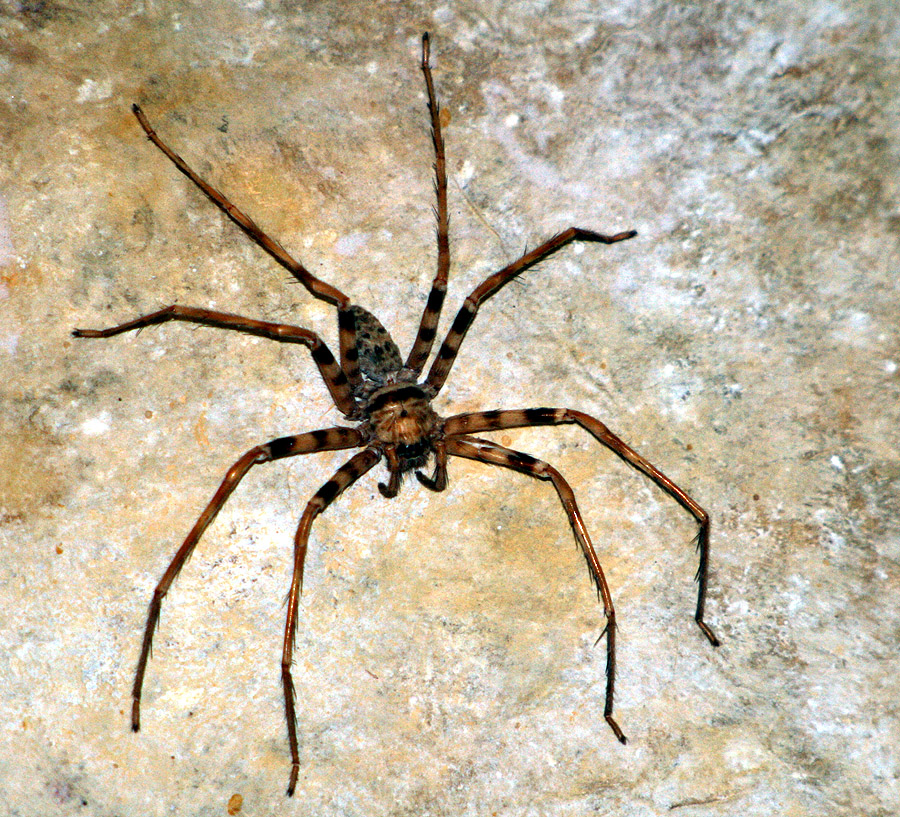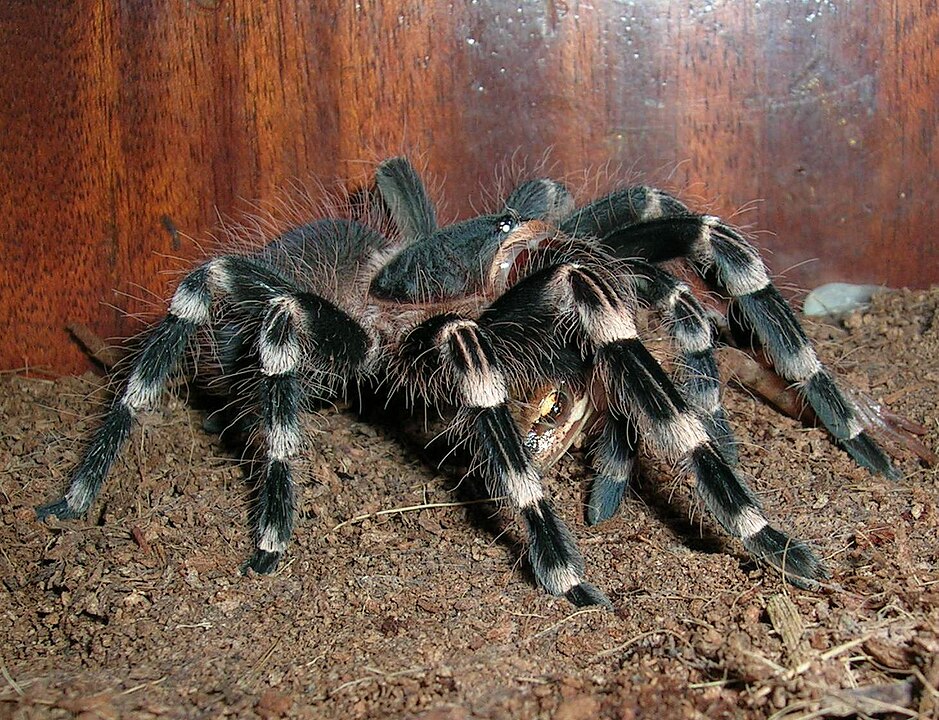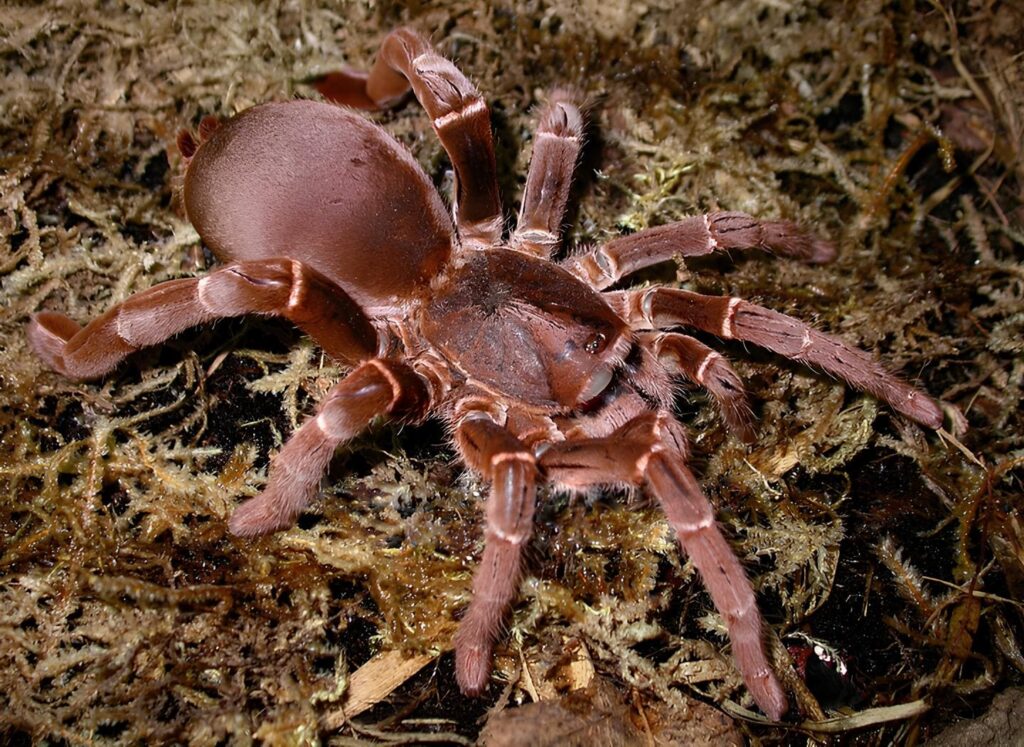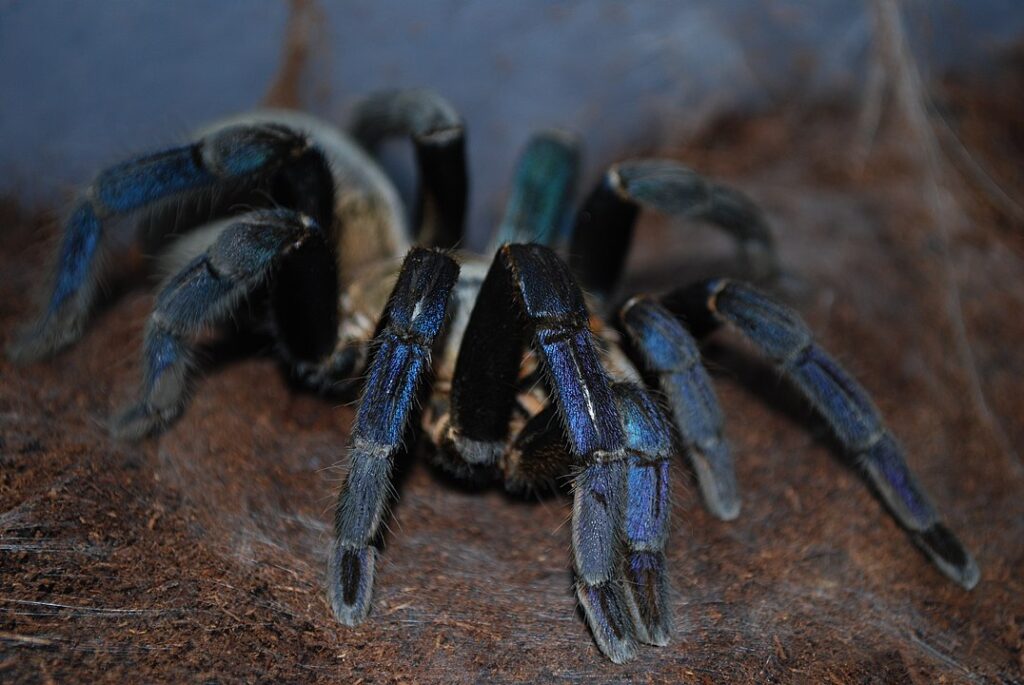Large spider species are found all over the world and many of them can reach quite impressive sizes. These spiders are considered one of nature’s most interesting creatures and arouse curiosity among humans. In this list, the 9 largest spiders in the world are listed in order from biggest to smallest.
- Goliath Birdeater (Theraphosa blondi)
- Giant Huntsman Spider (Heteropoda maxima)
- Brazilian Salmon Pink Bird-Eating Tarantula (Lasiodora parahybana)
- Brazilian Giant Tawny Red Tarantula (Pterinopelma sazimai)
- Brazilian Whiteknee Tarantula (Acanthoscurria geniculata)
- Colombian Giant Redleg Tarantula (Megaphobema robustum)
- King Baboon Spider (Pelinobius muticus)
- Goliath Pinkfoot Tarantula (Avicularia juruensis)
- Cobalt Blue Tarantula (Haplopelma lividum)
Goliath Birdeater (Theraphosa blondi)

The Goliath Birdeater is famous for its gigantic size, with a leg span that can reach up to 30 cm (12 in). It has a robust and hairy body covered in reddish-brown or dark brown fur, which gives it a distinctive and imposing appearance. Despite its intimidating size, it is important to note that the Goliath Birdeater is generally docile and not aggressive towards humans.
These giant spiders are found primarily in the rainforests of South America, including countries such as Brazil, Venezuela, and Suriname.
They usually live in burrows that they dig in the ground or build in hollow logs or tree roots.
Despite its name, the Goliath Birdeater does not primarily hunt birds. Although it may occasionally eat small birds, its diet consists mostly of insects, other spiders, and small mammals.
It is an opportunistic hunter and ambushes prey that get too close to its nest.
These spiders are nocturnal, meaning they are most active at night. Goliath Birdeaters are known for their unique defense mechanism, where they can grow creepy hairs from their abdomen when threatened. These prickly hairs can cause irritation to the skin and eyes of potential predators.
While female Goliath Birdeaters can live for decades, males have a much shorter lifespan. Mating involves a complex courtship ritual and males must approach females carefully to avoid being mistaken for prey.
Giant Huntsman Spider (Heteropoda maxima)

The Giant Hunter Spider is one of the largest spiders in the world, with a leg span that can reach up to 30 cm (about 12 in) and long, spindly legs and a relatively flat body. This spider can vary in color but usually has a brown or reddish-brown body with mottled patterns.
They live primarily in tropical and subtropical regions of Asia, including countries such as Laos, Vietnam, and Malaysia. They are often seen in forests, caves, and sometimes inside man-made structures.
As the word “hunter” in their name suggests, these spiders are skilled hunters. They do not spin traditional webs to catch their prey. So spiders are agile and fast-moving hunters that can catch these animals—insects and other small invertebrates.
Giant hunting spiders are nocturnal, meaning they are most active at night. They are known for their impressive speed and agility, which they use to catch their prey. While their large size can be intimidating, they are generally not considered dangerous to humans and are likely to flee from potential danger.
Brazilian Salmon Pink Bird-Eating Tarantula (Lasiodora parahybana)

The Brazilian Salmon Pink Bird-Eating Tarantula is one of the largest tarantula species in the world.
It boasts a leg span that can reach up to approximately 25 cm (10 in). The name “Salmon Pink” refers to its coloration, which typically includes a pinkish hue on its body and legs combined with brownish or grayish tones.
These tarantulas are native to Brazil, particularly the Atlantic rainforests of the Parahyba region. They are primarily ground-dwelling, constructing burrows in the soil.
Despite the common name, they do not primarily prey on birds. Instead, their diet mainly consists of insects, other arachnids, and small vertebrates like rodents. They are sit-and-wait predators, staying near their burrows and ambushing passing prey.
Brazilian Salmon Pink Bird-Eating Tarantulas are typically docile and are not known to be aggressive toward humans. When threatened, they may display a threat posture, raising their front legs and showing their fangs. Like many tarantulas, they have urticating hairs on their abdomen, which can be flicked as a defense mechanism to irritate potential predators.
Brazilian Giant Tawny Red Tarantula (Pterinopelma sazimai)
The Brazilian Giant Tawny Red Tarantula is a relatively large tarantula species, with a leg span that can reach up to around 23 cm (approximately 9 in). Its name reflects its distinctive coloration. These tarantulas typically have a tawny or reddish-brown hue on their bodies and legs.
These tarantulas are native to Brazil, particularly the state of Bahia, in the eastern part of the country. They inhabit tropical forests and are often found in burrows or crevices.
Like most tarantulas, the Brazilian Giant Tawny Red Tarantula is an opportunistic predator, feeding primarily on insects, other arachnids, and occasionally small vertebrates. They are ambush predators, relying on their sit-and-wait strategy to capture passing prey.
Brazilian Whiteknee Tarantula (Acanthoscurria geniculata)

The Brazilian Whiteknee Tarantula is a medium- to large-sized tarantula with a leg span that typically ranges from 18 to 20 cm (around 7 to 8 in). It is recognized by its distinct coloration, characterized by a dark-colored body with striking white bands or “knees,” on its legs.
These tarantulas are primarily found in the rainforests and tropical regions of Brazil. They often make burrows in the ground, which they use as shelters and for molting.
The Brazilian Whiteknee Tarantula is an opportunistic predator, feeding on various prey, including insects and small invertebrates. They are sit-and-wait predators, often ambushing their prey when it ventures close to their burrows.
Colombian Giant Redleg Tarantula (Megaphobema robustum)

The Colombian Giant Redleg Tarantula is a large tarantula with a leg span that can reach around 20 cm (about 8 in). Its striking and distinguishing feature is its vivid coloration. These tarantulas have dark bodies with striking red hairs on their legs, giving them the “redleg” name.
These tarantulas are native to Colombia, particularly the Andean region, but they are also found in other parts of South America. They are often discovered in mountainous areas, typically at higher elevations.
The Colombian Giant Redleg Tarantula is a carnivorous predator, feeding on a variety of prey, including insects and small invertebrates. Like most tarantulas, they employ a sit-and-wait hunting strategy, ambushing and capturing prey that comes near their burrows.
King Baboon Spider (Pelinobius muticus)

The King Baboon Spider is a large and robust tarantula with a leg span that can reach around 20 cm (approximately 8 in). It is characterized by its striking coloration, with a dark brown to black body and striking yellow bands on the legs. These bright markings give it a regal appearance, hence the name “King Baboon.”
This species is native to the tropical rainforests of East Africa, particularly in Tanzania and Kenya. They are often found in burrows or crevices in the ground or under logs and rocks.
The King Baboon Spider is an opportunistic predator, preying on a variety of creatures, including insects and small invertebrates. They are skilled ambush hunters, lying in wait near the entrance of their burrows to capture passing prey.
Goliath Pinkfoot Tarantula (Avicularia juruensis)

The Goliath Pinkfoot Tarantula is a relatively large arboreal tarantula species with a leg span that can reach up to approximately 20 cm (about 8 in). It gets its common name from the striking pinkish or reddish hairs on its feet, which stand out against its overall dark coloring.
These tarantulas are native to South America and are particularly found in regions such as Brazil, Venezuela, and Peru. They are arboreal by nature, which means they are well adapted for living in trees and are often found in forested areas.
The Goliath Pinkfoot Tarantula is an insectivore, preying primarily on a variety of insects, such as crickets, moths, and other arthropods. They are agile hunters, capturing prey using their silk threads as a web and ambushing them.
This species is known for being docile and is generally not aggressive towards humans. It is often kept as a pet by tarantula enthusiasts.
Cobalt Blue Tarantula (Haplopelma lividum)

The Cobalt Blue Tarantula is a medium-sized tarantula with a leg span that typically ranges from 13 to 15 cm (around 5 to 6 in). It is recognized for its striking cobalt blue color, which is the primary reason for its common name.
This species is native to Southeast Asia and is particularly found in countries like Thailand, Myanmar, and Malaysia. They are often discovered in tropical rainforests, where they make burrows in the ground or utilize crevices in rocks.
The Cobalt Blue Tarantula is an aggressive predator, feeding on a variety of prey, including insects, other arachnids, and small vertebrates. They are known for their agility and speed, effectively capturing their prey by ambushing or chasing them.
Unlike many other tarantula species, the Cobalt Blue Tarantula is known for its highly defensive and sometimes aggressive behavior. They are not typically docile and are often characterized by a strong-willed and skittish disposition.
The Cobalt Blue Tarantula is a highly prized species among tarantula enthusiasts due to its stunning blue coloration. However, its aggressive temperament makes it a challenging species to keep as a pet, and it is not recommended for novice tarantula keepers. In the wild, it plays a role in controlling insect and small vertebrate populations within its ecosystem.


